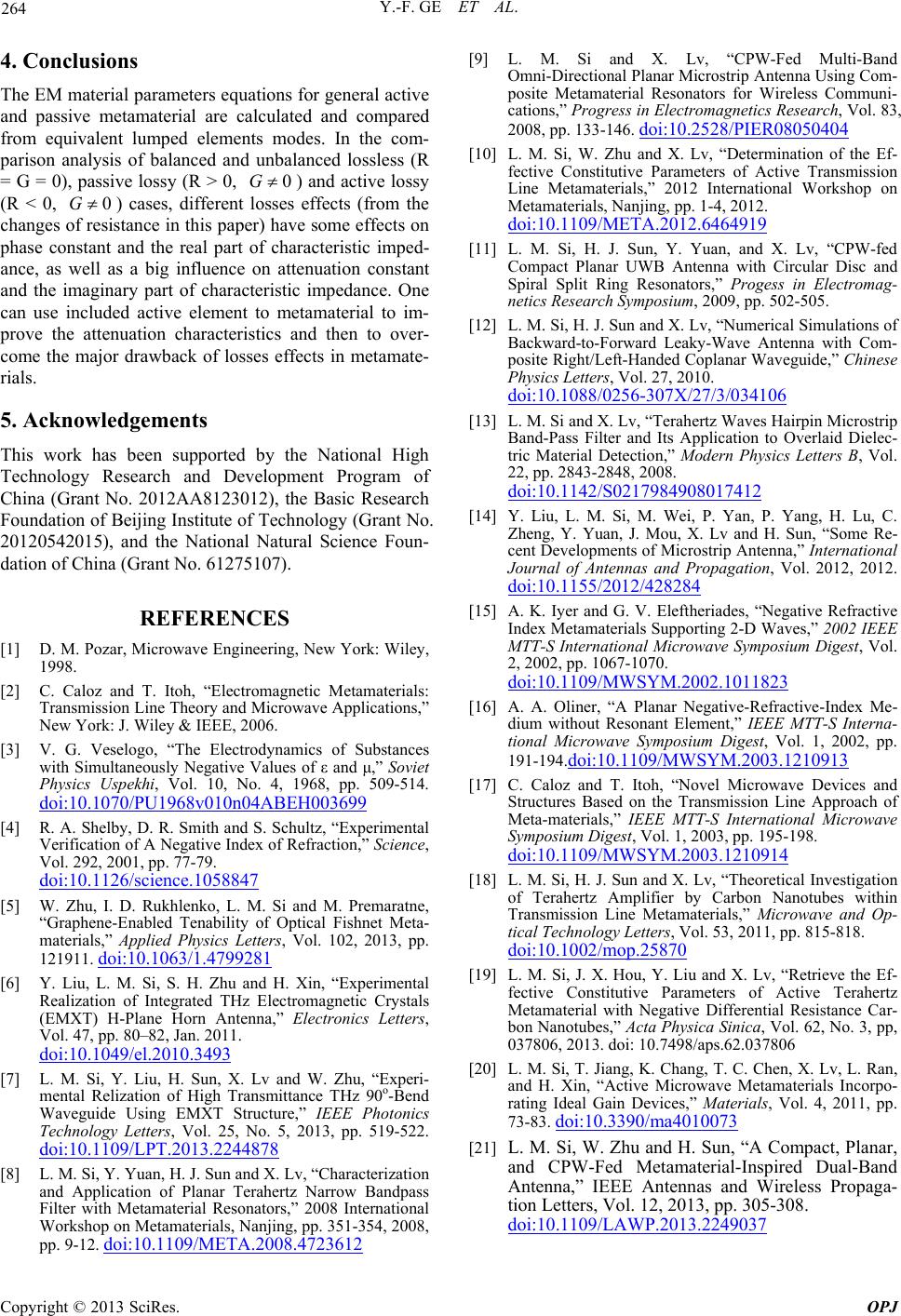
Y.-F. GE ET AL.
Copyright © 2013 SciRes. OPJ
264
4. Conclusions [9] L. M. Si and X. Lv, “CPW-Fed Multi-Band
Omni-Directional Planar Microstrip Antenna Using Com-
posite Metamaterial Resonators for Wireless Communi-
cations,” Progress in Electromagnetics Research, Vol. 83,
2008, pp. 133-146. doi:10.2528/PI ER08050404
The EM material parameters equations for general active
and passive metamaterial are calculated and compared
from equivalent lumped elements modes. In the com-
parison analysis of balanced and unbalanced lossless (R
= G = 0), passive lossy (R > 0, ) and active lossy
(R < 0, ) cases, different losses effects (from the
changes of resistance in this paper) have some effects on
phase constant and the real part of characteristic imped-
ance, as well as a big influence on attenuation constant
and the imaginary part of characteristic impedance. One
can use included active element to metamaterial to im-
prove the attenuation characteristics and then to over-
come the major drawback of losses effects in metamate-
rials.
0G
0G
[10] L. M. Si, W. Zhu and X. Lv, “Determination of the Ef-
fective Constitutive Parameters of Active Transmission
Line Metamaterials,” 2012 International Workshop on
Metamaterials, Nanjing, pp. 1-4, 2012.
doi:10.1109/META.20 12.6464919
[11] L. M. Si, H. J. Sun, Y. Yuan, and X. Lv, “CPW-fed
Compact Planar UWB Antenna with Circular Disc and
Spiral Split Ring Resonators,” Progess in Electromag-
netics Research Symposium, 2009, pp. 502-505.
[12] L. M. Si, H. J. Sun and X. Lv, “Numerical Simulations of
Backward-to-Forward Leaky-Wave Antenna with Com-
posite Right/Left-Handed Coplanar Waveguide,” Chinese
Physics Letters, Vol. 27, 2010.
doi:10.1088 /0256-307X /27/3/034106
5. Acknowledgements [13] L. M. Si and X. Lv, “Terahertz Waves Hairpin Microstrip
Band-Pass Filter and Its Application to Overlaid Dielec-
tric Material Detection,” Modern Physics Letters B, Vol.
22, pp. 2843-2848, 2008.
doi:10.1142 /S02179849080 17412
This work has been supported by the National High
Technology Research and Development Program of
China (Grant No. 2012AA8123012), the Basic Research
Foundation of Beijing Institute of Technology (Grant No.
20120542015), and the National Natural Science Foun-
dation of China (Grant No. 61275107).
[14] Y
. Liu, L. M. Si, M. Wei, P. Yan, P. Yang, H. Lu, C.
Zheng, Y. Yuan, J. Mou, X. Lv and H. Sun, “Some Re-
cent Developments of Microstrip Antenna,” International
Journal of Antennas and Propagation, Vol. 2012, 2012.
doi:10.1155 /2012/428284
[15] A. K. Iyer and G. V. Eleftheriades, “Negative Refractive
Index Metamaterials Supporting 2-D Waves,” 2002 IEEE
MTT-S International Microwave Symposium Digest, Vol.
2, 2002, pp. 1067-1070.
doi:10.1109/MWSYM.200 2.1011823
REFERENCES
[1] D. M. Pozar, Microwave Engineering, New York: Wiley,
1998.
[2] C. Caloz and T. Itoh, “Electromagnetic Metamaterials:
Transmission Line Theory and Microwave Applications,”
New York: J. Wiley & IEEE, 2006.
[16] A. A. Oliner, “A Planar Negative-Refractive-Index Me-
dium without Resonant Element,” IEEE MTT-S Interna-
tional Microwave Symposium Digest, Vol. 1, 2002, pp.
191-194.doi:10.1109/MW SYM.2003.1210913
[3] V. G. Veselogo, “The Electrodynamics of Substances
with Simultaneously Negative Values of ε and μ,” Soviet
Physics Uspekhi, Vol. 10, No. 4, 1968, pp. 509-514.
doi:10.1070 /PU1968v010n 04ABEH0 03699
[17] C. Caloz and T. Itoh, “Novel Microwave Devices and
Structures Based on the Transmission Line Approach of
Meta-materials,” IEEE MTT-S International Microwave
Symposium Digest, Vol. 1, 2003, pp. 195-198.
doi:10.1109/MWSYM.200 3.1210914
[4] R. A. Shelby, D. R. Smith and S. Schultz, “Experimental
Verification of A Negative Index of Refraction,” Science,
Vol. 292, 2001, pp. 77-79.
doi:10.1126/scien ce.1058847 [18] L. M. Si, H. J. Sun and X. Lv, “Theoretical Investigation
of Terahertz Amplifier by Carbon Nanotubes within
Transmission Line Metamaterials,” Microwave and Op-
tical Technology Letters, Vol. 53, 2011, pp. 815-818.
doi:10.1002 /mop.25870
[5] W. Zhu, I. D. Rukhlenko, L. M. Si and M. Premaratne,
“Graphene-Enabled Tenability of Optical Fishnet Meta-
materials,” Applied Physics Letters, Vol. 102, 2013, pp.
121911. doi:10.1063/1.4799281
[19] L. M. Si, J. X. Hou, Y. Liu and X. Lv, “Retrieve the Ef-
fective Constitutive Parameters of Active Terahertz
Metamaterial with Negative Differential Resistance Car-
bon Nanotubes,” Acta Physica Sinica, Vol. 62, No. 3, pp,
037806, 2013. doi: 10.7498/aps.62.037806
[6] Y. Liu, L. M. Si, S. H. Zhu and H. Xin, “Experimental
Realization of Integrated THz Electromagnetic Crystals
(EMXT) H-Plane Horn Antenna,” Electronics Letters,
Vol. 47, pp. 80–82, Jan. 2011.
doi:10.1049 /el.2010.3493 [20] L. M. Si, T. Jiang, K. Chang, T. C. Chen, X. Lv, L. Ran,
and H. Xin, “Active Microwave Metamaterials Incorpo-
rating Ideal Gain Devices,” Materials, Vol. 4, 2011, pp.
73-83. doi:10.3390/ma4010073
[7] L. M. Si, Y. Liu, H. Sun, X. Lv and W. Zhu, “Experi-
mental Relization of High Transmittance THz 90o-Bend
Waveguide Using EMXT Structure,” IEEE Photonics
Technology Letters, Vol. 25, No. 5, 2013, pp. 519-522.
doi:10.1109 /LPT.2013.22448 78 [21] L. M. Si, W. Zhu and H. Sun, “A Compact, Planar,
and CPW-Fed Metamaterial-Inspired Dual-Band
Antenna,” IEEE Antennas and Wireless Propaga-
tion Letters, Vol. 12, 2013, pp. 305-308.
doi:10.1109 /LAWP.2013.2 249037
[8] L. M. Si, Y. Yuan, H. J. Sun and X. Lv, “Characterization
and Application of Planar Terahertz Narrow Bandpass
Filter with Metamaterial Resonators,” 2008 International
Workshop on Metamaterials, Nanjing, pp. 351-354, 2008,
pp. 9-12. doi:10.1109/META .2008.47236 12